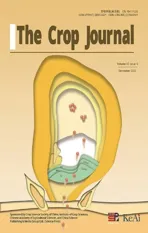Effects of increasing panicle-stage N on yield and N use efficiency of indica rice and its relationship with soil fertility
2022-12-02ChangYeHengyuMaXiuHuangChunmeiXuSongChenGuangChuXiufuZhangDanyingWang
Chang Ye,Hengyu Ma,Xiu Huang,Chunmei Xu,Song Chen,Guang Chu,Xiufu Zhang,Danying Wang
The State Key Laboratory of Rice Biology,China National Rice Research Institute,Hangzhou 310006,Zhejiang,China
Keywords:Indica rice Panicle-N Yield Nitrogen use efficiency Soil fertility
ABSTRACT Because of the higher nitrogen(N)recovery efficiency(NRE)of panicle-stage fertilization compared with basal and tillering fertilization,increasing the proportion of N topdressing at the booting stage(panicle-N)is recommended and commonly practiced in parts of China.To investigate the effects of increasing panicle-N on grain yield and N use efficiency(NUE)and the relationships of the increase and the rice cultivar and soil fertility status,we increased the percentage of panicle-N from 20% to 40% by correspondingly reducing the N amount applied only at the tillering stage in both high-and low-fertility blue clayey paddy fields in 2018 and 2019.Four indica cultivars with diverse panicle types were used,and their grain yield,dry matter accumulation,and NUE were compared.In high-fertility soil,increasing topdressing panicle-N from 20% to 40% reduced tillering ability and reduced the effective panicle numbers of the multi-and medium-panicle cultivars Huanghuazhan(HHZ),C Liangyouhuazhan(CHZ),and Tianyouhuazhan(THZ).These cultivars gave the greatest yield when 30% of N was supplied as panicle fertilizer,whereas the yield,NRE,N agronomic efficiency(NAE),and nitrogen physiological efficiency(NPE)of the heavy-panicle inbred cultivar Yangdao 6(YD6)continued to increase,resulting in improved dry matter accumulation and grain filling in the late growth stage.The yield,NAE,NRE,and NPE of YD6 peaked when the panicle-N constituted 40%.While in low-fertility soil,the multipanicle cultivar HHZ showed the greatest yield when 30% of fertilizer-N was applied once at the panicle initiation(PI)stage,while the medium-panicle cultivar CHZ showed the greatest yield when the panicle-N percentage was 40%.Our results suggest that the percentage of panicle-N fertilizer should not exceed 30% for multipanicle cultivars,while can be appropriately increased to 40%for heavy-panicle indica cultivars.The effect of increasing topdressing panicle-N on the yield of medium-panicle cultivars was related to soil fertility.The optimum panicle-N percentage was 30% in the high-fertility soil and 40% in the low-fertility soil.
1.Introduction
To ensure higher yields,a large amount of nitrogen(N)fertilizer has been applied during rice production in China during the past two decades[1-3].Compared with the global average N application of 74 kg N ha-1,the value in China is as high as 305 kg N ha-1,but the N use efficiency(NUE)is only 25%,far lower than the global average of 42%[3,4].In rice production in China,excessive amounts of N fertilizer application and improper management have caused many adverse environmental impacts associated with N leaching,runoff,and volatilization[5,6],severely reducing the sustainability of rice production.
In rice production in China,a strategy involving multiple applications of N fertilizer is widely used,in which N fertilizer is divided into basal-N,tiller-N and panicle-N.Basal-N is applied and mixed into the soil before or during transplanting,and tiller-N is topdressed at 7-14 d after transplanting(DAT).Generally,basal-N and tiller-N account for respectively 40%-60% and 20%-30% of total N applied.The function of basal and tiller fertilizers is to promote rice tillering at the seedling stage.Panicle-N is topdressed at the panicle development stage and usually accounts for 20%-30%of the total fertilizer N.The function of panicle-N is to increase the number of differentiated spikelets,prevent premature senescence,and increase the number of filled grains and dry matter weight[7,8].
Owing to the limited root production and weak absorption capacity at the seedling stage,a large amount of N fertilizer applied at this time cannot be absorbed immediately,and the NRE of basal-N and tiller-N(10%-30%)are much lower than that of panicle-N(30%-80%)[2,9,10].To improve NUE,proper fertilizer management to reduce the amount of basal-N and tiller-N while increasing the amount of panicle-N is recommended,and the percentage of panicle-N in some areas is increased from 20% to 30% to 40% and even 50%.Although many studies have been performed to determine a suitable percentage of panicle-N,previous research results have not been consistent and some have even been contradictory.Sun et al.[11]reported that applying 40%fertilizer-N at the panicle initiation(PI)stage increased plant N accumulation after anthesis,NUE,and grain yield of indica hybrid cultivars,whereas Wu et al.[12]found that once the amount of panicle-N exceeded 35%,grain filling was reduced.Wang[13]reported that rice had the highest yields when panicle-N accounted for 30%,while Liu et al.[14]found that there was little difference in rice yield and N accumulation when panicle-N accounted for 20%-40%.Xu[15]proposed that the effect of panicle-N amount on rice yield was associated with soil fertility;once the yield of a no-N control(0 N)exceeded 7000 kg ha-1,the yield-increasing effect of panicle-N diminished.These studies suggested that the effects of increasing the percentage of panicle-N on grain yield might be associated with N rate,cultivar,and soil fertility.We previously found[16]that the proportion of panicle-N applied to japonica rice should not exceed 30% in clayey paddy fields and that fertilizer management in rice production should be modified according to soil type,soil fertility,and cultivar.For indica rice,although previous studies[17,18]have shown that the yield-increasing effect of N fertilizer decreased with an increase in soil fertility and that the optimal N application rate in high-fertility soil was far lower than that in low-fertility soil,the relationships between optimum N application proportion,cultivar,and soil fertility have remained unclear.
To investigate the effects of increasing topdressing panicle-N on the yield of several types of indica rice and the relationship of this increase with soil fertility,field experiments were performed in 2018 and 2019.Four indica cultivars of three panicle types widely grown in the middle and lower reaches of the Yangtze River were studied.The effects of varying proportions of panicle-N on rice grain yield and dry matter accumulation in high-and lowfertility blue clayey paddy soils were measured.
2.Materials and methods
2.1.Site description and experimental design
Field experiments were conducted in 2018 and 2019 at the China National Rice Research Institute(CNRRI)(30.30°N,120.20°E,11 m above sea level),Zhejiang province,China.Two paddy fields with the same blue clayey paddy soils but different levels of soil fertility were selected as experimental sites.Soil samples were collected from the upper 20-cm soil layer at each site in the early season of 2018 and 2019,and the primary soil properties were determined[19](Table 1).The sunshine hours,daily mean temperature,and precipitation during the rice growth period in 2018 and 2019 are shown in Fig.1.

Table 1Basic chemical properties of the experimental soil(0-20 cm soil layer).
Four indica cultivars were used:two inbreds,Huanghuazhan(HHZ)and Yangdao 6(YD6),and two hybrids,C Liangyouhuazhan(CHZ)and Tianyouhuazhan(THZ).According to their tillering and yield components,YD6,an inbred with medium tillering capacity but high grain production(<200×104panicles ha-1,>29 g 1000 grains-1,4.4-5.2 g panicle-1),was characterized as a heavy-panicle cultivar.HHZ,is a multipanicle-type cultivar with strong tillering capacity but relatively low grain production per panicle and grain weight(280-300×104panicles ha-1,160-180 grains panicle-1,20 g 1000 grains-1,3.0-3.2 g panicle-1).Both the hybrid cultivars CHZ and THZ have a medium panicle number and panicle size(260-280×104panicles ha-1,180-220 grains panicle-1,21-23 g 1000 grains-1,3.4-4.4 g panicle-1)and were characterized as medium-panicle cultivars.All these cultivars are widely planted in southern China.
Both experiments were performed in high-fertility and lowfertility paddy fields using a split-plot design with three replications.A total of 210 kg N ha-1was applied in the form of granular urea.The main plots were N application proportions,and the subplots were cultivars.
In the high-fertility field,there were three different N application proportions:a basal-N:tiller-N:panicle-N of 40%:40%:20%(F1),40%:30%:30%(F2)and 40%:20%:40%(F3),plus a control treatment(F0)in which no N was provided.The subplots comprised the above four indica cultivars(YD6,HHZ,CHZ and THZ),and the size of each subplot was 20 m2.Basal-N was broadcast 1 d before transplanting,and tiller-N and panicle-N were topdressed 10 DAT and 26-30 d before flowering(at the PI stage),respectively.
In the low-fertility soil,to reduce the possible adverse yield effects of a single large application of panicle-N,panicle-N was applied twice when the panicle-N percentage was greater than or equal to 30%.Thus,panicle-N was applied once at the PI stage(26-30 d,3.5 leaves remaining)if its percentage was only 20%and twice-once at the PI stage and again 5-7 d before flowering(1.0 leaves remaining)-if its percentage was 30% or 40%.Thus,a total of 7 N treatments were applied in low-fertility fields.The treatments were as follows:basal-N:tiller-N:panicle-N when 3.5 leaves remained:panicle-N when 1.0 leaf remained=40%:40%:20%:0%(T1),40%:30%:20%:10%(T2),40%:30%:30%:0%(T3),40%:20%:20%:20% (T4), 40%:20%:30%:10% (T5) and 40%:20%:40%:0%(T6),plus a no-N control(T0).In the above treatments,the panicle-N percentage of T1 was 20%;that of T2 and T3 was 30%;and that of T4,T5,and T6 was 40%.In the low-fertility field,only the multipanicle indica cultivar HHZ and the mediumpanicle indica cultivar CHZ were planted,and the size of each subplot was 12 m2.
To further measure the absorption and utilization of panicle-N,a microplot of 0.6×0.4 m was isolated within each subplot with a polyvinyl chloride(PVC)board with a height of 0.30 m.In this microplot,15N-labeled urea(10.1515N atom%)was used as panicle-N to distinguish basal-and tiller-N,both of which were applied as conventional urea.
Rice was sown on May 23 in both years and transplanted on June 15 in 2018 and June 17 in 2019.The transplanting density was 25.0×20.0 cm with two plants per hill.In all experiments,potassium(189.0 kg K2O ha-1)was applied in the form of KCl,with 50%as basal fertilizer and 50%as panicle fertilizer,and phosphorus(97.5 kg P2O5ha-1)was applied as basal fertilizer in the form of calcium superphosphate.The basal fertilizer was broadcast and incorporated into the paddy soil one day before transplanting,tillering fertilizer was topdressed 10 DAT,and panicle fertilizer was topdressed at the PI stage.To avoid cross-fertilization,each subplot was coated with black plastic film and was fertilized and drained separately.The field was flooded after transplanting,and a depth of 1-4 cm of flooding water was maintained until seven days before maturity except for drainage at the maximum tillering stage to reduce unproductive tillers.Pests and diseases were intensively controlled with chemicals to avoid biomass and yield losses.
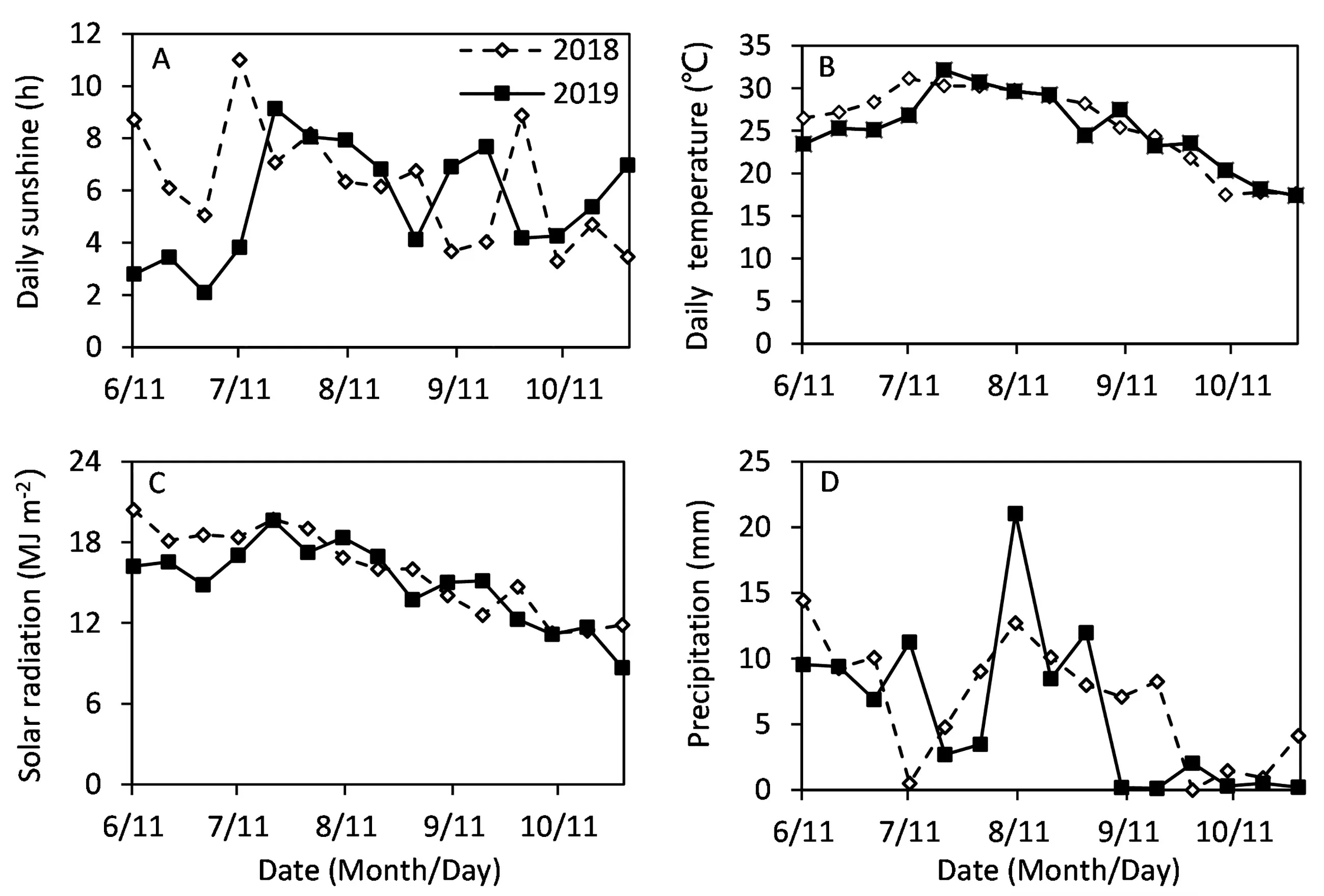
Fig.1.Daily sunshine hours(A),temperature(B),mean solar radiation(C),and precipitation(D)during the rice growth period in 2018 and 2019.
2.2.Data collection and statistical analysis
At heading and maturity,the effective panicles of 20 rice hills were counted,and six hills that had average effective panicle numbers were sampled from each subplot.All sampled plants were divided into leaf blade(leaf),stem plus sheath(stem),and panicle at heading,and straw and panicle at maturity.The dry weight of each part was determined after oven drying at 70 °C for 48 h to constant weight.At maturity,the grain yield was determined from a harvested area of 5 m2and was converted to that with 14%moisture content.The grains of the six sampled hills were threshed and divided into filled and unfilled kernels by immersion in tap water,and unfilled grains were further divided into empty grains and half-filled kernels by winnowing.The numbers of filled,halffilled and empty grains were determined with a Yield Traits Scorer(YTS-4,Green Pheno Technology Co.,Ltd.,Wuhan,Hubei,China),and the total grain number,number of grain s per panicle,and grain-filling percentage were calculated.The aboveground dry weight at maturity was the total dry matter of the shoots,rachises,and filled and unfilled grains.The N content was determined by the Kjeldahl digestion and steam distillation methods,and the15N atom% was determined with a MAT-271 mass spectrometer(MS)(Thermo Finnigan,San Jose,CA,USA).Plant N uptake,plant15N uptake,nitrogen agronomic efficiency(NAE),nitrogen recovery efficiency(NRE)and nitrogen physiological efficiency(NPE)were calculated[20-22].The calculation formula is as follows:.

where a is the atom%15N in the plant sample;b is the atom%15N in the samples taken from control plots which received unlabeled urea;c is the atom%15N in the urea;and d is the natural atom%15N in air(0.3664 atom%15N).
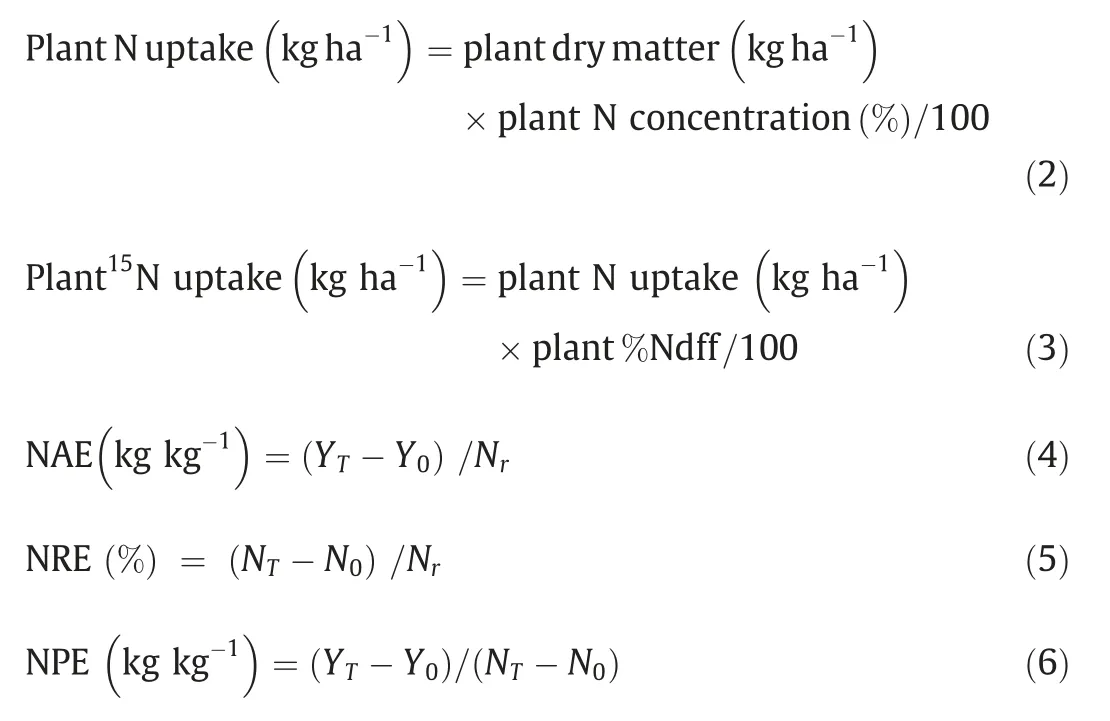
where YTand NTare the yield and plant N uptake of N treatments,respectively;Y0and N0are respectively the yield and plant N uptake of no-N control;Nris the amount of N fertilizer applied.
Statistical analysis was performed with Statistical Analysis System(SAS;version 9.2,SAS Institute,Cary,NC,USA);the data for 2018 and 2019 were analyzed separately.A two-factor split-plot analysis of variance was conducted for all of the abovementioned parameters from three replicates at harvest.Yield and dry weight comparisons were made among the various combinations of N rates and cultivars using Duncan’s multiple range test.
3.Results
There were sharp differences in the numbers of daily sunshine hours and mean temperature during the vegetative growth period(before mid-July)between 2018 and 2019(Fig.1).The rice grew better in 2018 than in 2019 and showed greater effective panicle numbers and grain yield in 2018.Because the error homogeneity assumption for the experimental data between 2018 and 2019 was rejected,an analysis of variance(ANOVA)for grain yield,yield components,dry matter accumulation,and NUE was fitted for the experimental data of 2018 and 2019 separately(Table S1).All of the main effects:panicle N percentage(N)and cultivar(C),and their N×C interactions were significant at the 5% level,except for the N for dry matter accumulation(P-value=0.999)in 2019.
3.1.Effects of increasing topdressing panicle-N on rice growth and yield formation in high-fertility soil
In the high-fertility soil,the grain yield of the indica cultivars in 2018 ranged from 8078 to 10,454 kg ha-1,values greater than those in 2019(8022-9403 kg ha-1)(Table 2).Further analysis of yield components and dry matter accumulation showed that the number of effective panicles in 2018 was 26.3% greater than that in 2019,although the number of grains per panicle was slightly lower;the number of grains per unit area in 2018 was 14.4%greater than that in 2019.The dry matter accumulation at full heading in 2018 was 7.4%greater than that in 2019 but 5.4%lower at the grain-filling stage,and there was no significant difference between years at maturity(Table 3).
There were significant differences in yield among cultivars(Table S1).The medium-panicle cultivar CHZ had the highest grain yield in both years,whereas the heavy-panicle inbred cultivar YD6 had the lowest value.Marked differences between cultivars were observed in the response to N treatment(Table S1).The multipanicle and medium-panicle cultivars HHZ,CHZ,and THZ gave the highest yield when 30% of N was supplied as panicle fertilizer(F2),and significant decreases(respectively 8.3%and 6.9%)in grain yield were observed in the multipanicle cultivar HHZ and in the medium-panicle cultivar THZ when the panicle-N percentage increased from 30%(F2)to 40%(F3).However,the yield of the heavy-panicle inbred cultivar YD6 continued to increase with increasing panicle-N percentage,and its yields under F3 were respectively 3.7% and 7.7% greater than those under F1 and F2(Table 2).
Yield-component analysis showed that those cultivars with decreased yield under a high panicle-N percentage(HHZ,THZ and CHZ)had significantly lower effective panicle numbers in F3 than in F1 and F2,whereas no difference in effective panicle number was observed for the heavy-panicle cultivar YD6(Table 2).Further analysis of tiller dynamics showed that the highest tiller number of the three last-mentioned cultivars decreased significantly with increasing panicle-N percentage(the tiller-N percentage decreased correspondingly)(Fig.2).Compared with those of the treatment in which 20%of the N was applied as panicle fertilizer(F1),the maximum tiller numbers of HHZ,CHZ and THZ in which 40% on the N was applied at the PI stage(F3)were 12.0%,6.1%and 11.5%lower,respectively.Although their productive tiller percentages increased correspondingly,these increases were not enough to offset the large decrease in the maximum tiller numbers and resulted in a decrease in effective panicle number.However,there was no significant difference in the occurrence of tillers and the formation of effective panicles in the heavy-panicle inbred cultivar YD6,which has weak tillering ability.
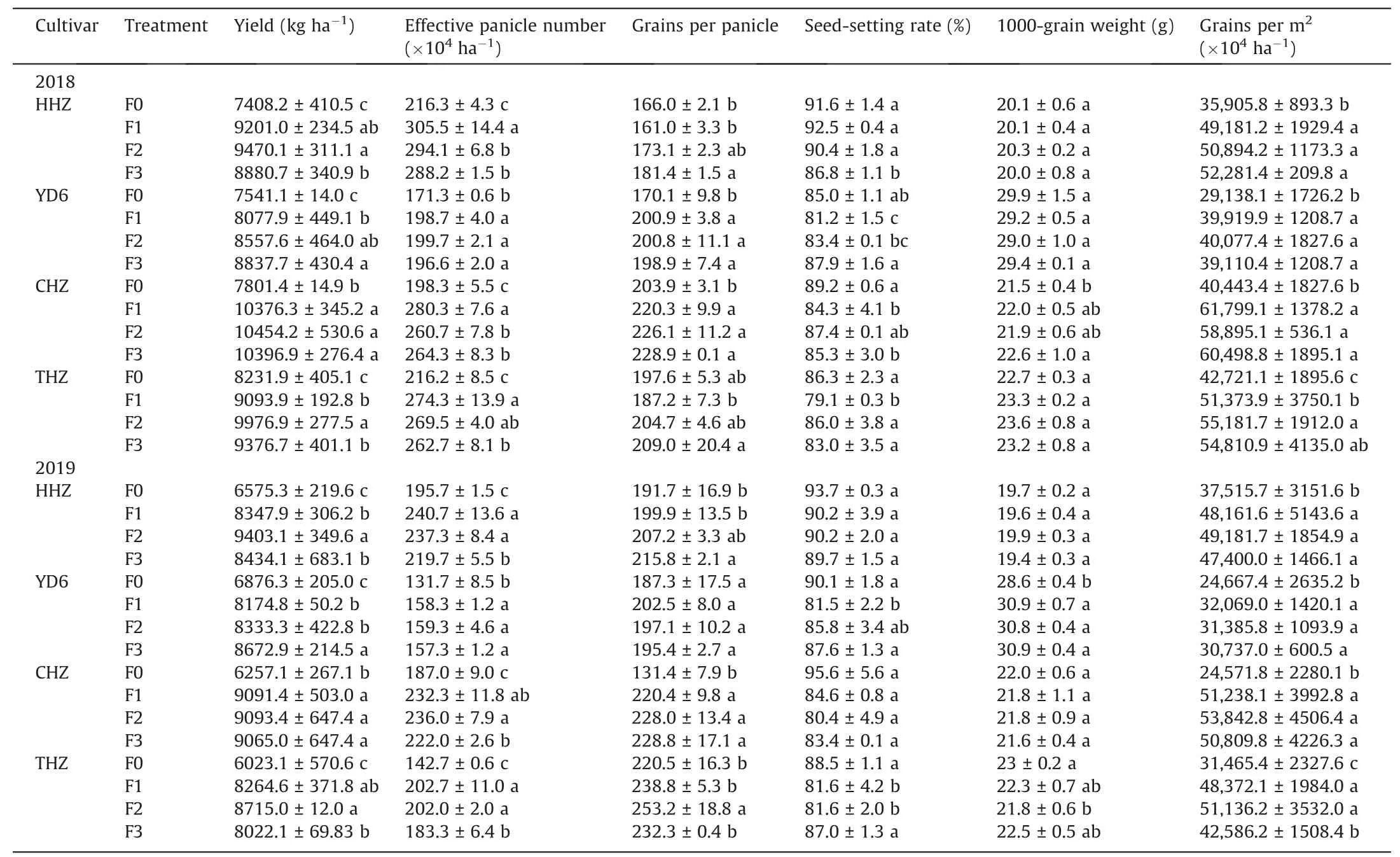
Table 2Grain yield and yield components of indica rice grown in high-fertility soil in 2018 and 2019.
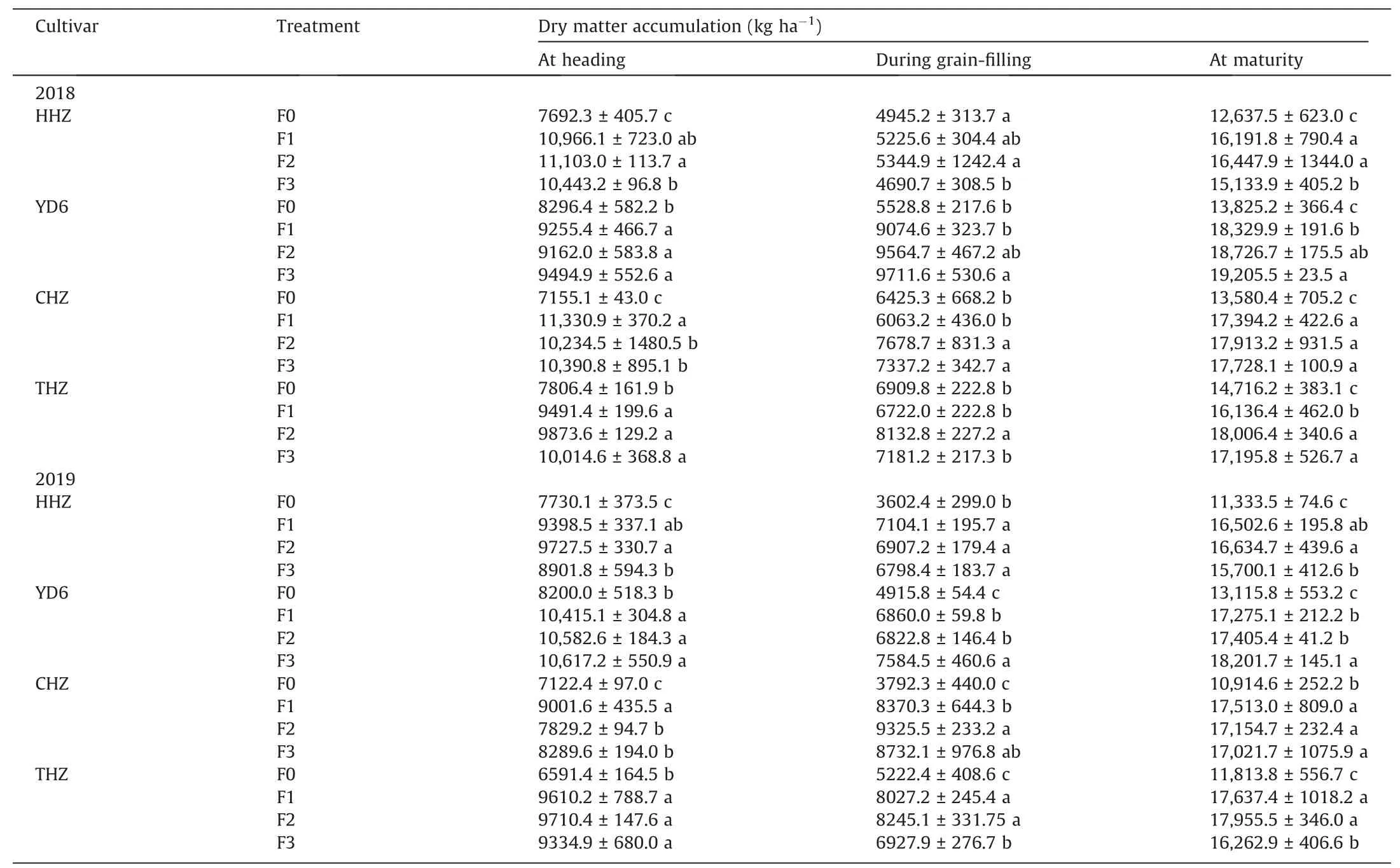
Table 3Dry matter accumulation of indica rice grown in high-fertility soil in 2018 and 2019.
Increasing the percentage of topdressing panicle-N increased the grains per panicle but decreased the seed setting rate of the multipanicle inbred cultivar HHZ;its number of grains per panicle under F3 was greater than those under F1 and F2 by 7.5%and 4.8%,respectively,in 2018,and by 3.7% and 4.2% in 2019,while its seed setting rate under F3 was 6.2% and 4.0% lower than that under F1 and F2 in 2018.In contrast to the effect on HHZ,increasing topdressing panicle-N application on the heavy-panicle cultivar YD6 increased the seed setting rate but showed no effect on the number of grains per panicle,and its seed setting rate under F3 was 8.3%and 7.5%greater than that under F1 in 2018 and 2019,respectively.Although both cultivars are medium-panicle-type hybrids,the responses of grains per panicle and seed setting rate of CHZ and THZ to the increase in panicle-N percentage were different.Increasing the percentage of topdressing panicle-N showed no effect on the grains per panicle or seed setting rate of CHZ in either year but showed a significant effect THZ.The grains per panicle of THZ was significantly higher(by 8.3%)under F2 than under F3,while the seed setting rate was significantly lower(by 6.6%)than under F3 in 2019.No significant difference in 1000-grain weight was detected between the N treatments for any cultivar.
Significant differences were also observed in the effects of increasing the proportion of panicle-N topdressing application on dry matter accumulation among different types of cultivar in high-fertility soil(Table S1).For the multipanicle inbred cultivar HHZ,the dry matter accumulation at both the full heading and the maturity stages were greatest in F2,followed by F1,and smallest in F3,with the difference between F2 and F3 significant in both years.For the heavy-panicle cultivar YD6,there were no significant differences in the dry matter weight between any of the treatments at full heading(Table 3),but the dry matter weight increase under F3 was greatest during the grain-filling period,resulting in the dry matter weight under F3 at maturity being significantly greater than that under F1 in 2018 and under both F1 and F2 in 2019.Both the medium-panicle cultivars CHZ and THZ are panicle size-and number-coordinated hybrid cultivars,and their dry matter weight response to panicle-N percentage was different before heading but the same at the grain-filling stage.At the full heading stage,CHZ had the greatest dry matter accumulation in F1,but THZ presented similar dry weights in all treatments;during the grainfilling period,the greatest dry matter increase of both the two hybrid cultivars was observed in F2.At maturity,there was no significant difference in dry matter weight among the treatments or the cultivar CHZ,while for the cultivar THZ,the value under F2 was significantly higher than that under F1(by 11.6%)in 2018 and under F3(by 10.4%)in 2019.

Fig.2.Tillering dynamics and productive tiller number(PTN),maximum tiller number(MTN),and productive tiller percentage(PTP)of indica rice grown in high-fertility soil in 2019.HHZ,Huanghuazhan;CHZ,C Liangyouhuazhan;THZ,Tianyouhuazhan;YD6,Yangdao 6.
3.2.Effects of increasing topdressing panicle-N on yield formation and dry matter accumulation in low-fertility soil
In low-fertility soil,the mean grain yields were 5475-7350 kg ha-1in 2018 and 6069-8355 kg ha-1in 2019(Table 4).Unlike that in high-fertility soil,the mean yield of indica rice was significantly greater in 2019 than in 2018.
In the low-fertility soil,the effects of increasing topdressing panicle-N application on yield were associated with cultivar and panicle fertilizer application method(Table 4).For the multipanicle cultivar HHZ,when the panicle-N percentage was increased from 20% to 30%,applying panicle-N one time at the PI stage(T3)increased the yield by 13.1%in 2018 and by 25.9%in 2019,whereas no yield advantage was observed when panicle-N was applied twice(T2).When panicle-N continued to increase to account for 40% of total N,the yield decreased significantly regardless of whether panicle-N was applied once or twice.Analysis of the yield components revealed that this was mainly because the number of effective panicles decreased when panicle-N increased while tiller-N ratio decreased correspondingly.The mean effective panicles in T4-T6(40% panicle-N)were 12.6%and 12.5%lower than the average value of T2-T3(30%panicle-N)in 2018 and 2019,respectively.
For the medium-panicle cultivar CHZ,increasing topdressing panicle-N application in the low-fertility soil increased the grain yield.The yield of T6(in which 40%of the N was supplied as a single application at the PI stage)was significantly greater than that in T1(in which 20% of the N was supplied as a single application at the PI stage)by 16.3% and 26.2% in 2018 and 2019,respectively(Table 4).In all treatments with 30% and 40% N applied as panicle-N,the yield from applying panicle-N twice was lower than that of applying panicle-N once.Yield component analysis showed that although the 40%panicle-N treatment led to no significant difference in effective panicle number or grain per panicle compared with those of the other treatments,this treatment resulted in the highest 1000-grain weight,especially when the N was applied once at the PI stage.The 1000-grain weight of T6 was greater than that of T1 by 6.0% and 4.5% in 2018 and 2019,respectively.
Correlation analysis of yield and yield components showed that the yield of the multipanicle and medium-panicle cultivars were significantly and positively correlated with the number of effective panicles and grain per unit area,while the yield of the heavypanicle cultivar YD6 was not significantly correlated with the above two indexes but was significantly and positively correlated with seed setting rate(Table 5).The seed setting rate and dry matter accumulation during the grain-filling period of the heavypanicle-type cultivar YD6 increased with the increase in the panicle-N fertilizer percentage,as did the grain yield(Table 2).
Marked differences were observed in the effects of N treatment on dry matter accumulation(Tables S1,6).For the multipanicle cultivar HHZ,the maximum dry matter accumulations both before and after heading were observed in the panicle-N treatment in which N was applied once at the PI stage(T3)and accounted for 30%.For the medium-panicle cultivar CHZ,the dry matter accumulation both before and after heading increased with panicle-N percentage when the N was applied once at the PI stage;this resulted in the maximum value occurring in T6,which was greater than that in T1 and T3 by 59.4%and 13.7%,respectively,in 2018 and by 82.0% and 25.5% in 2019,respectively.Compared with the single application,the split application of panicle-N significantly reduced the amount of dry matter increase during the grain-filling period when the panicle-N percentage was 30% in both years;when the panicle fertilizer N was 40%,the split-application application of panicle-N(T4,T5)significantly reduced the dry matter accumulation during the grain-filling in 2018 compared with that in response to the single application(T6),whereas the difference among application methods in 2019 was relatively small.
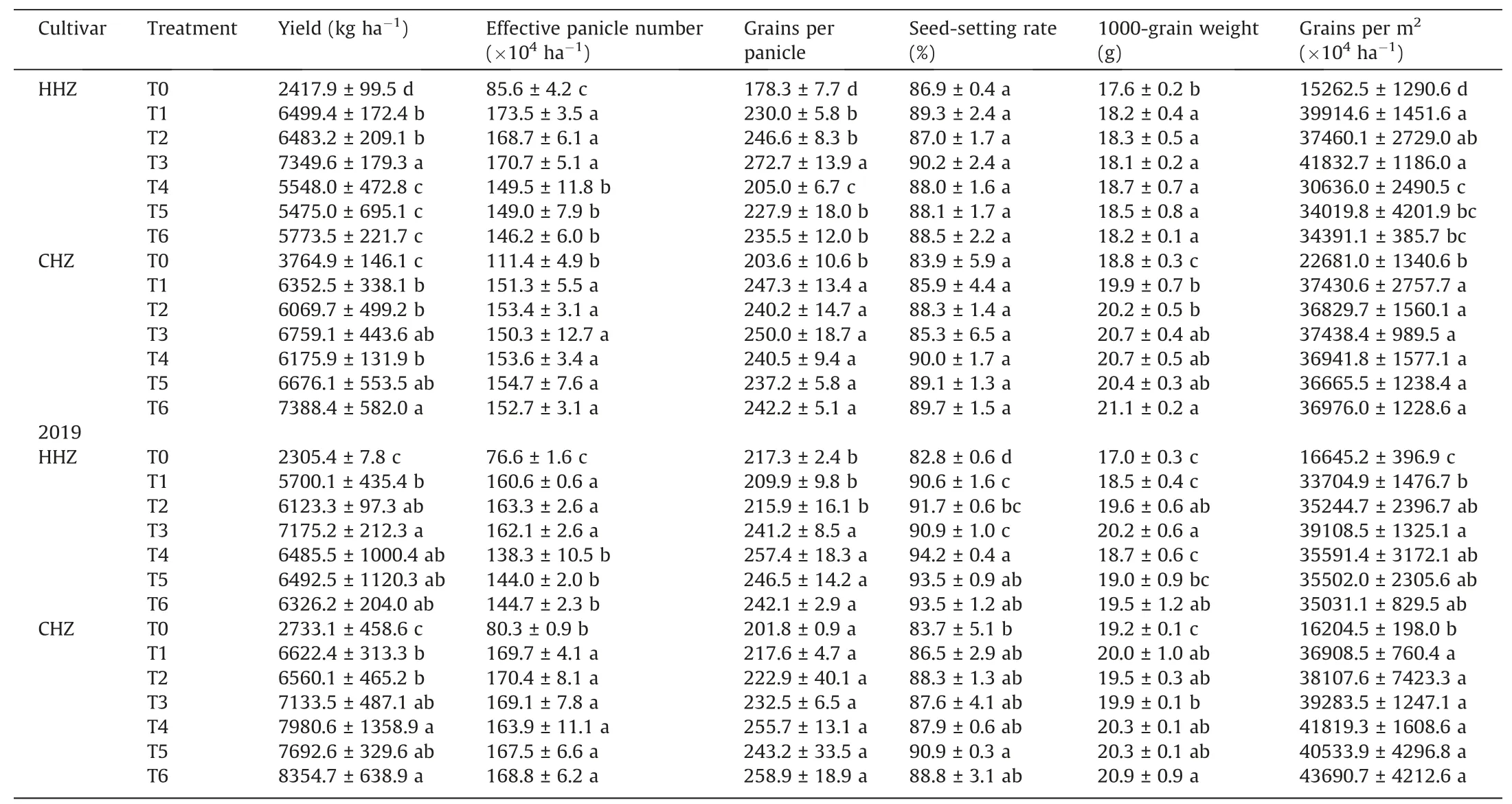
Table 4Grain yield and yield components of indica rice grown in the low-fertility soil in 2018 and 2019.

Table 5Correlation analysis between yield and yield components.
3.3.Effects of increasing topdressing panicle-N on plant N accumulation and NUE in high-fertility soil
The N contents of different plant parts and plant N accumulation at the full heading and mature stages were compared(Figs.3 and 4).In the multipanicle cultivar HHZ,increasing the percentage of panicle-N from 30%(F2)to 40%(F3)significantly reduced the N content of stem at full heading and the N content of straw and panicle at maturity in both 2018 and 2019,resulting in a significantly greater plant N accumulation in F2 than in F3.In the heavy-panicle cultivar YD6,the increase of panicle-N percentage increased the N content of leaves at full heading and the N content of rice straw at maturity in both years,and F3 showed the greatest plant N accumulation at both the full heading and maturity stages.In the two medium-panicle cultivars CHZ and THZ,there was no significant difference in N content of stem,leaf,or panicle among N treatments at either the heading or maturity stages in 2018.However,in 2019,the response of the two cultivars to the increase of panicle-N percentage at full heading was different;the N content of cultivar CHZ in F3 was significantly lower than that of F2,whereas for cultivar THZ the value of F3 was higher than that of F2.No significant difference in plant N accumulation at maturity was observed between F3 and F2 in cultivar CHZ,but the value of F3 was significantly lower than that of F2 in cultivar THZ.
In the high-fertility soil,the mean NAE,NRE and NPE values of the indica cultivars in 2018 were respectively 8.02 kg kg-1N,36.34%,and 22.61 kg kg-1N(Table 7),values lower than those in 2019(11.19 kg kg-1N,47.21% and 23.46 kg kg-1N,respectively).Significant differences in the effects on NUE of increasing topdressing panicle-N application between the different cultivars were observed.The maximum NAE,NRE and NPE continued to increase with increasing percentage of panicle-N in the heavy-panicle cultivar YD6.The NAE,NRE and NPE of F3 were significantly greater than those of F1 by 186.7%,39.8% and 105.6%,respectively,in 2018 and by 102.4%,62.4% and 22.3%,respectively in 2019 and were significantly greater than those of F2 by 95.2%,24.5% and 56.9%,respectively,in 2018 and by 72.6%,20.9% and 48.2%,respectively,in 2019(Table 7).In the multipanicle cultivar HHZ and medium-panicle cultivar THZ,the maximum NAE and maximum NRE in both years were recorded in F2.However,no significant difference was observed in NAE,NRE and NPE between the treatments in the other medium-panicle hybrid cultivar,CHZ,were recorded in either year.
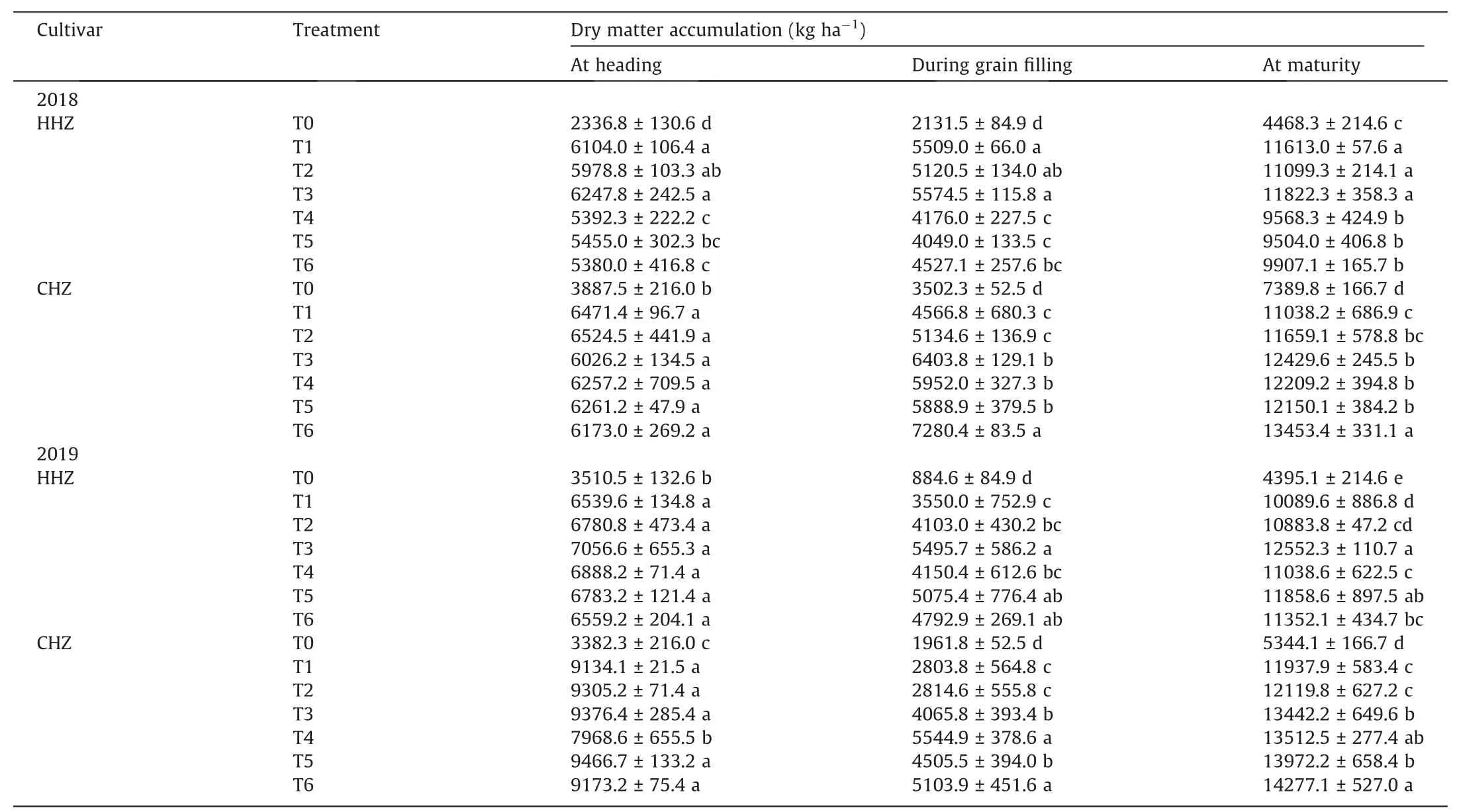
Table 6Dry matter accumulation of indica rice grown in the low-fertility soils in 2018 and 2019.
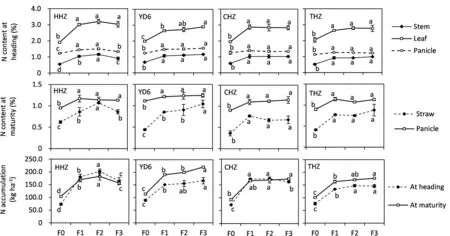
Fig.3.N content of plant parts and plant N accumulation of indica rice grown in high-fertility soil in 2018.HHZ,Huanghuazhan;CHZ,C Liangyouhuazhan;THZ,Tianyouhuazhan;YD6,Yangdao 6.
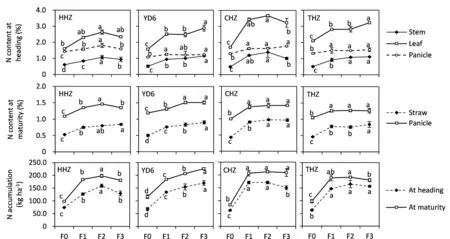
Fig.4.N content of plant parts and plant N accumulation of indica rice grown in high-fertility soil in 2019.HHZ,Huanghuazhan;CHZ,C Liangyouhuazhan;THZ,Tianyouhuazhan;YD6,Yangdao 6.

Table 7N use efficiency of indica rice grown in the high-fertility soil in 2018 and 2019.
3.4.Effects of increasing topdressing panicle-N on plant N accumulation and NUE in low-fertility soil
In low-fertility soil,when 20%,30% and 40% N were used as panicle-N and applied once at PI(T1,T3 and T6,respectively)in the multi-panicle cultivar HHZ and the medium-panicle cultivar CHZ,the N content of stems at full heading in 2018 and the N content of leaves at full heading in 2019 increased with panicle-N percentage,while the N content of rice straw and panicle at maturity led to no significant difference among the treatments(Fig.5).The plant N accumulation of the multipanicle cultivar HHZ at the full heading and maturity stages first increased and then decreased with the increase of panicle-N percentage,and the value of T3 at the maturity stage was significantly higher than that of T6 in both years;while in medium-panicle cultivar CHZ,the plan N accumulation at maturity increased and remained at a high level with the increase of panicle-N percentage,and the values of T6 were significantly higher than those of T1 in both years.
Compared with the single application of panicle-N,the effect of double application of panicle-N on the N content of stem and leaves at heading and on the N content of straw at maturity were different in 2018 and 2019(Fig.S1).In the multipanicle cultivar HHZ,compared with single panicle-N application(T3),the double application of 30%panicle-N(T2)reduced plant N accumulation at full heading in 2018 and at maturity stage in 2019,while whether or not 40%panicle-N was split-applied showed no effect on plant N accumulation:no significant differences were observed between T4,T5,and T6 at either the full heading or maturity stages(Fig.6).In the medium-panicle cultivar CHZ,double application of 30%panicle-N(T2)increased plant N accumulation at full heading in 2018 compared with a single application(T3)but showed no effect on N accumulation at the maturity stage.There was no significant difference between T4,T5,and T6 at maturity in either year when 40% N was applied as panicle-N.
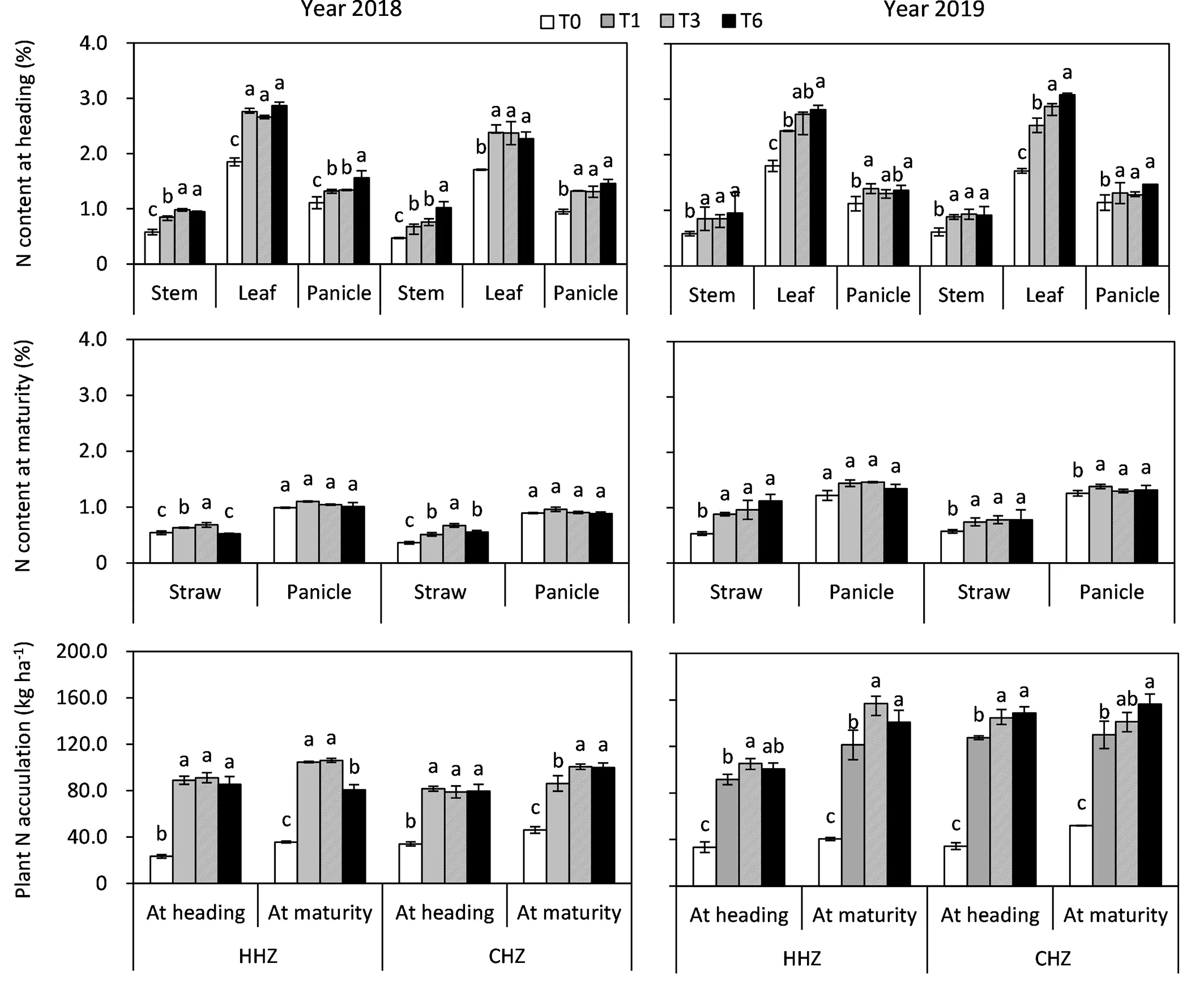
Fig.5.N content of plant parts and N accumulation in plants grown in low-fertility soil with one-time application of panicle-N in 2018 and 2019.HHZ,Huanghuazhan;CHZ,C Liangyouhuazhan;THZ,Tianyouhuazhan;YD6,Yangdao 6.

Fig.6.N accumulation in plants grown in low-fertility soil with two applications of panicle-N in 2018 and 2019.HHZ,Huanghuazhan;CHZ,C Liangyouhuazhan.
In the low-fertility soil,the mean NAE and NRE values of the indica cultivars were lower in 2018 than in 2019(Table 8),and the NAE and NRE of the multipanicle cultivar HHZ were significantly greater than those of the medium-panicle cultivar CHZ.Similar responses of NAE and NRE to the panicle-N percentage were observed for the multipanicle cultivar HHZ in low-and highfertility soil.The maximum value was observed in T3,in which panicle-N accounted for 30% and was applied once at the PI stage(Table 8).Compared with two applications,a single application of panicle-N at the PI stage was also found to yield a significantly greater NAE in the medium-panicle cultivar CHZ.In the two treatments in which panicle-N accounted for 30%,the NAE of T3(single application)was significantly greater than that of T2(splitapplication)by 21.1% and 15.0% in 2018 and 2019,respectively;in the three treatments in which 40%of the N was applied as panicle fertilizer,the NAE of T6(single application)was greater than that of T4(in which 20% of N was applied at the PI stage and 20%was applied 5-7 d before flowering)by 50.3% and 25.8% in 2018 and 2019,respectively,greater than that of T5(in which 30% of N was applied at the PI stage and 10% was applied 5-7 d before flowering)by 24.5% and 13.3% in 2018 and 2019,respectively.

Table 8N use efficiency of indica rice grown in the low-fertility soil in 2018 and 2019.
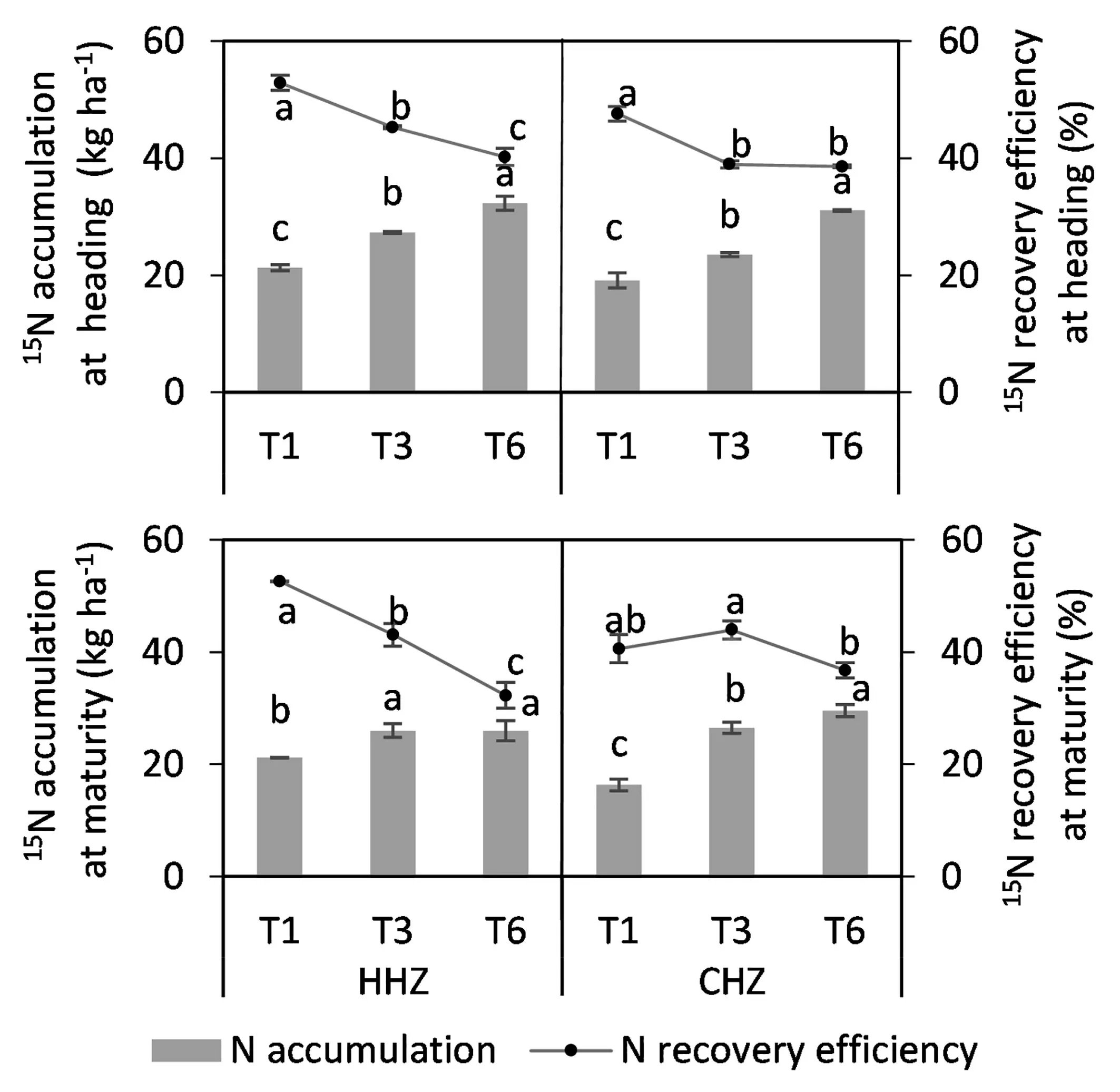
Fig.7.Plant 15N accumulation and 15N recovery efficiency of indica rice grown in low-fertility soil in 2018.HHZ,Huanghuazhan;CHZ,C Liangyouhuazhan.
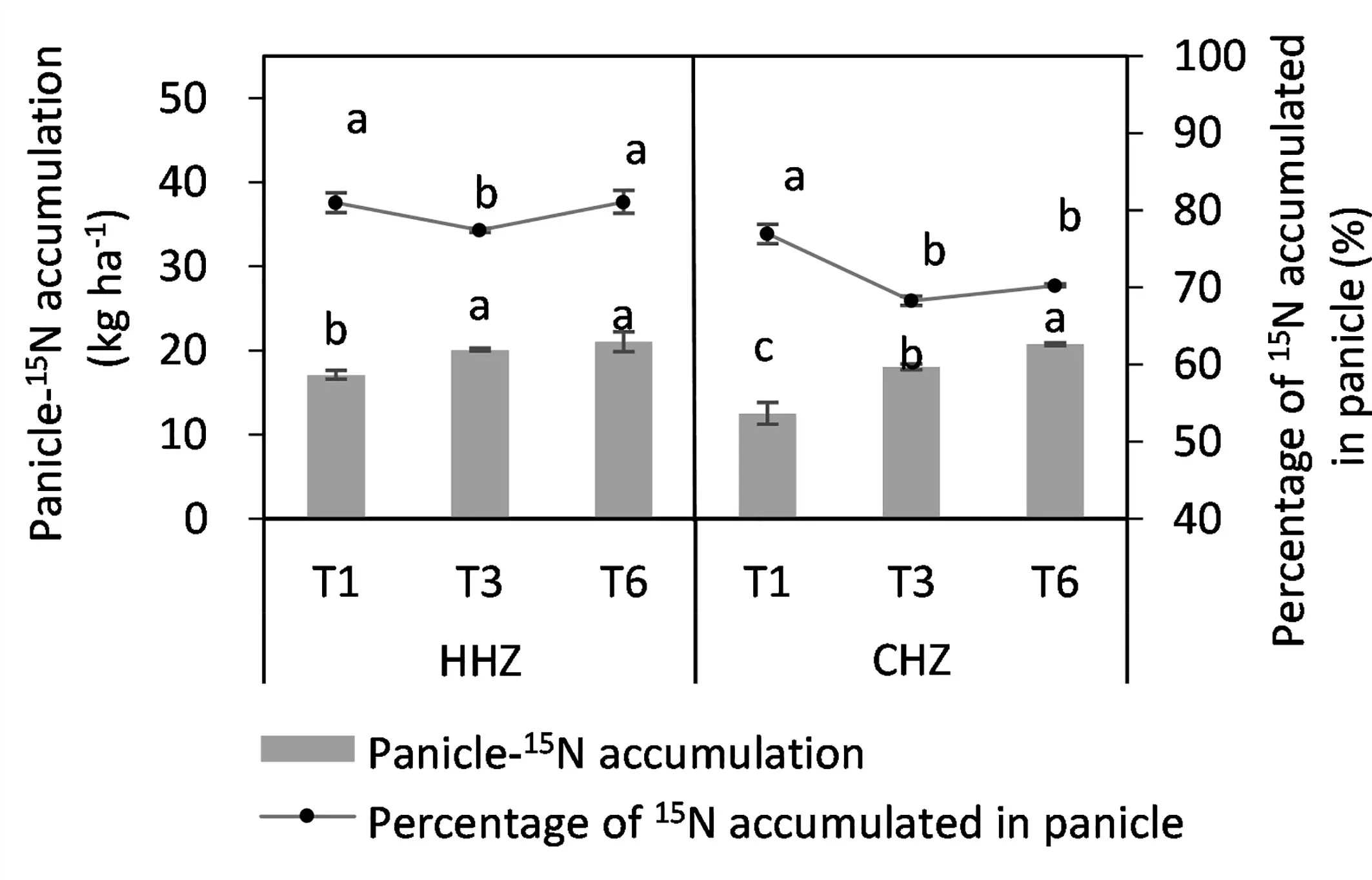
Fig.8.The amount and percentage of 15N accumulated in panicle at maturity in 2018 in the low-fertility soil.HHZ,Huanghuazhan;CHZ,C Liangyouhuazhan.
In the low-fertility soil,to further analyze the uptake and use of a single application of panicle-N,15N-labeled urea was applied as panicle-N in the T1,T3 and T6 treatments to distinguish the panicle-N from the basal-N and tiller-N.In the multipanicle cultivar HHZ,15N accumulation increased continuously with increasing panicle-N percentage at the full heading stage,but no significant difference was observed between T3 and T6 at maturity(Fig.7),and15NRE at both the full heading and mature stages decreased continuously with increasing panicle-N percentage.In the medium-panicle cultivar CHZ,the15N accumulation increased continuously at both the full heading and the maturity stages,the15NRE of T1 was significantly higher than that of T3 and T6 at the full heading stage,and the15NRE of T3 was highest at maturity stage.
In total,68%-81% of the panicle-15N absorbed by plants was allocated to panicles(Fig.8).With the increase in panicle-N percentage,the percentage of15N in the panicles of both cultivars first decreased and then increased,and the percentage of T3 was significantly lower than that of T1 and T6.The effect of panicle-N percentage on panicle-15N amount was similar to that of total plant-15N accumulation.T1 showed significantly lower plant-15N accumulation in the multipanicle cultivar HHZ,whereas panicle-15N accumulation in the medium-panicle cultivar CHZ continued to increase,and T6 showed the greatest panicle-15N accumulation.
4.Discussion
Interannual differences in yield and dry matter accumulation of indica rice cultivars differed between high-and low-fertility soils.In the high-fertility soil,grain yield and dry matter accumulation in 2019 were lower than those in 2018,while in the low-fertility soil,the values in 2019 were greater than those in 2018.This difference was likely due to the less favorable light and temperature conditions during the tillering stage in 2019 than in 2018.The daily mean temperature,solar radiation and sunshine hours for 30 DAT in 2019 were respectively 25.2 °C,16.16 W m-2and 3.0 h,lower than the 28.31 °C,18.9 W m-2and 7.7 h in 2018.Poor light and temperature conditions impair rice tillering[23].In our experiment,the effective panicle number and grains per unit area in the high-fertility soil in 2019 were 20.8% and 12.6% lower than those in 2018.The observation in the low-fertility soils of no difference between the two years may be explained as follows:the main limiting factor of rice growth in the early stage in low-fertility soil is nutrient deficiency,whose effect is greater than those of low temperature and low illumination.
Previous studies[24-26]have shown that increasing the amount of topdressing panicle-N could control the number of ineffective tillers of indica rice and increase the number of effective panicles.In the present study,increasing the amount of topdressing panicle-N by reducing the tiller fertilizer percentage reduced tiller formation and reduced the effective panicle numbers of three of the four indica rice cultivars.This inconsistency may be due to differences in cultivars and soil fertility.
On the basis of the number and size of their panicles,rice cultivars can be divided into multipanicle types with small panicles,such as the cultivar HHZ;medium-panicle types with coordinated panicle number and size,such as the hybrid cultivars THZ and CHZ;and large/heavy-panicle types with many grains or high grain weight,such as cultivar YD6.The yield formation,grain filling,and dry matter accumulation characteristics of these types differ[27].Ma et al.[28]and Mou et al.[29]investigated the photosynthetic characteristics of rice with diverse panicle types and found greater photosynthetic ability in heavy-panicle cultivars than in medium-or small-panicle-type rice at the full heading stage.These growth differences also lead to differing nutrient demands among cultivars.Heavy-panicle type cultivars need more nutrients in the reproductive growth stage and application of a large amount of panicle fertilizer was suggested[30]to meet the continuous nutrient demands that occur during the reproductive growth period.If the nutrient supply is limited at this time,the grain filling of inferior grains is inhibited[31-33].Owing to their small panicles,the nutrient demand of cultivars with multiple panicles in the reproductive stage was less than that of the heavy-panicle-type cultivars,but a sufficient nutrient supply at the tillering stage was recommended to ensure the production of a certain number of productive tillers[30].Multipanicle-type cultivars had a higher recovery efficiency for tiller fertilizer,and the optimum panicle-N percentages for heavy-panicle-and multipanicle-type cultivars were 32.46% and 26.26%,respectively.
The differences in nutrient demand of different panicle-type cultivars were also reflected in their response to split application of panicle-N.It was proposed[34-36]that panicle-N applied at PI increased the number of differentiated spikelets,panicle-N applied at SD reduced the number of degenerated spikelets,and N fertilization at HD delayed senescence and improved harvest index by maintaining higher photo-assimilation rates.However,the effectiveness of panicle-N application timing in increasing grain yield and NUE varied largely with rice cultivars differing in panicle size[37].Panicle-N applied at PI was most effective in increasing gain yield and NUE for cultivars with small panicle size,and panicle-N applied at SD or HT was most effective for cultivars with large panicle size;whereas for cultivars with medium panicle size,no significant difference was found in the yield and NUE of panicle-N application at PI,SD and split applied at both stages.Similar results were found in our experiment,when 30% or 40%N was twice applied as panicle-N(once at the PI stage and again 5-7 d before flowering)in the low-fertility soil,the yield,dry matter accumulation,and NUE of the multipanicle cultivar HHZ and the medium-panicle cultivar CHZ were not greater than those in the corresponding treatments of panicle-N applied once at PI.
In contrast with the conclusion of Mou et al.[29],who believed that grains per panicle plays a very important role in yield formation,the yields of both multi-and medium-panicle rice in the present were significantly and negatively correlated with grains per panicle.Thus,in those cultivars,the increase in grains per panicle with the increase in panicle-N percentage was not enough to make up for the loss of yield caused by the decrease in effective panicle number.It is well known[38-41]that soil fertility strongly influences rice yield formation and NUE:approximately 40%-60% of the N absorbed by plants originates in the soil,and the more fertile the soil,the smaller is the contribution of fertilizer N to plants.In the present study,experiments were performed on high-fertility and low-fertility blue clayey paddy soils.Compared with that of the rice grown in the low-fertility soil,the yield of the rice grown in the high-fertility soil was 53.6% and 29.3% greater,while the yield gap between the fertilizer treatments and the no-N control treatment was 33.3% and 47.2% in 2018 and 2019,respectively.Yield component analysis showed that the effects of soil fertility on the number of effective panicles was significantly greater than that of grains per panicle.Rice grown in the high-fertility soil had 80.0% and 44.4%greater effective panicle numbers and 17.1% and 8.6% fewer grains per panicle compared with those of rice growing in the low-fertility soil in 2018 and 2019,respectively.
Previous studies[42-44]of soil fertility and NUE showed that high soil fertility improved plant N absorption.Peng[45]reported that the NRE of low-,medium-and high-fertility paddy soils was 16%,18%and 25%,respectively.In our study,we not only compared the NRE of rice grown in soils with different fertility levels but also determined the NAE and NPE,and the NRE results were consistent with those of previous studies.Compared with that of rice grown in the low-fertility soil,the NRE of rice grown in the highfertility soil increased by 28.4%and 8.1%in 2018 and 2019,respectively,while the NAE decreased by 38% and 44%,respectively,and the NPE decreased by 50.8% and 40.3%,respectively.
In our previous study[16]on japonica rice,regardless of whether panicle-N was applied as a single application or split application,increasing the percentage of panicle-N had no effect on the yield components or dry matter accumulation of plants grown in either high-or low-fertility soils.In the present study of indica cultivars,the effects of increasing topdressing panicle-N on yield and NUE of different types of indica rice were associated with soil fertility.When the topdressing N amount is constant,increasing the percentage of panicle-N topdressing increases the nutrient supply during the reproductive growth period but correspondingly reduces the N supply in the early stage of vegetative growth.This phenomenon was unfavorable to the growth of cultivars that need more nutrients in the early stage but was beneficial to the heavy-panicle cultivar,which needs more nutrients in the later stage.In summary,although the multipanicle cultivar HHZ gave the greatest yield when panicle-N accounted for 30% in both the high-and the low-fertility soils,the effective panicle numbers of HHZ and the dry matter accumulation in the early stage were reduced when the panicle-N percentage continued to increase to 40%.In the medium-panicle cultivar CHZ,because the number of grains per panicle increased with the increased panicle-N percentage in the low-fertility soil,which was enough to offset the adverse impact on yield caused by the decrease in effective panicle number,the optimum percentage of panicle-N was 30% in the high-fertility soil and 40%in the low-fertility soil.
5.Conclusions
In blue clayey paddy soil,increasing topdressing panicle-N from 20% to 40% reduced tillering and effective panicle numbers in the multipanicle cultivar HHZ,but this reduction increased dry matter accumulation and grain filling in the late growth stage of the heavy-panicle cultivar YD6.The percentage of panicle fertilizer of the multipanicle indica cultivar should not exceed 30%,but can be appropriately increased to 40% for the heavy-panicle indica cultivar.The effects of reducing the amount of N topdressing on the yield of the medium-panicle cultivar were associated with soil fertility;the optimum panicle-N percentage was 30% in the high-fertility soil and 40% in the low-fertility soil.
CRediT authorship contribution statement
Chang Ye:Conceptualization,Writing-original draft,Investigation.Hengyu Ma:Writing-review & editing,Investigation.Xiu Huang:Investigation.Chunmei Xu:Investigation.Song Chen:Data curation.Guang Chu:Data curation.Xiufu Zhang:Project administration.Danying Wang:Data curation,Conceptualization,Data curation,Writing-review & editing.
Declaration of competing interest
The authors declare that they have no known competing financial interests or personal relationships that could have appeared to influence the work reported in this paper.
Acknowledgments
This research was supported by the China Agriculture Research System(CARS-01-04A)and the National Natural Science Foundation of China(31371581).
Appendix A.Supplementary data
Supplementary data for this article can be found online at https://doi.org/10.1016/j.cj.2022.02.003.
杂志排行
The Crop Journal的其它文章
- Profiling seed soluble sugar compositions in 1164 Chinese soybean accessions from major growing ecoregions
- The mitochondria-localized protein OsNDB2 negatively regulates grain size and weight in rice
- Integrated linkage mapping and genome-wide association study to dissect the genetic basis of zinc deficiency tolerance in maize at seedling stage
- Delaying application time of slow-release fertilizer increases soil rhizosphere nitrogen content,root activity,and grain yield of spring maize
- Yield sustainability of winter wheat under three limited-irrigation schemes based on a 28-year field experiment
- Identification of a stable major QTL for fresh-seed germination on chromosome Arahy.04 in cultivated peanut(Arachis hypogaea L.)
